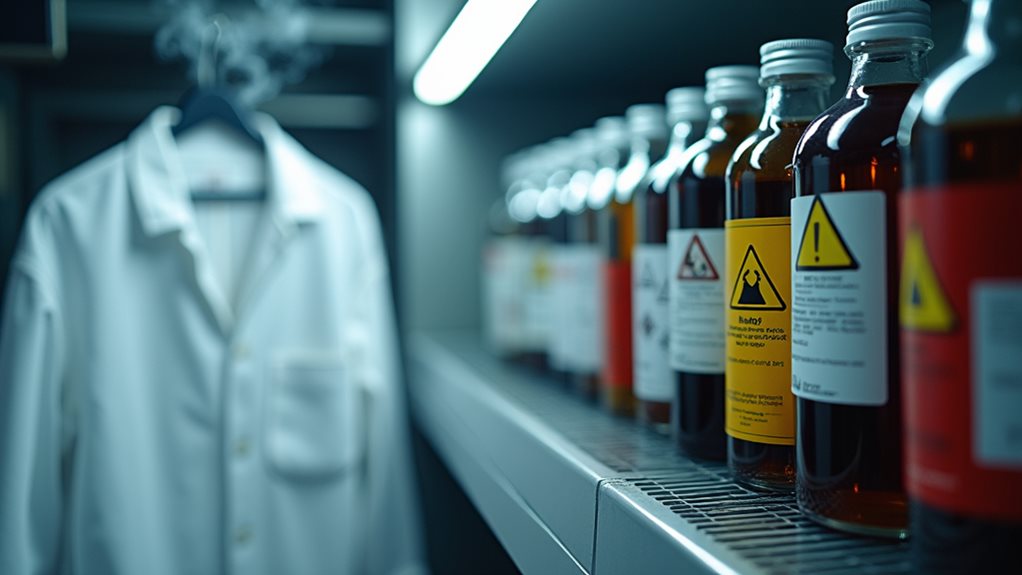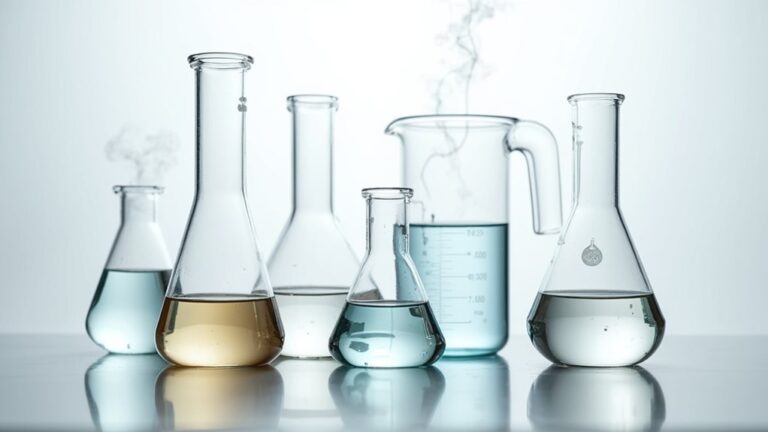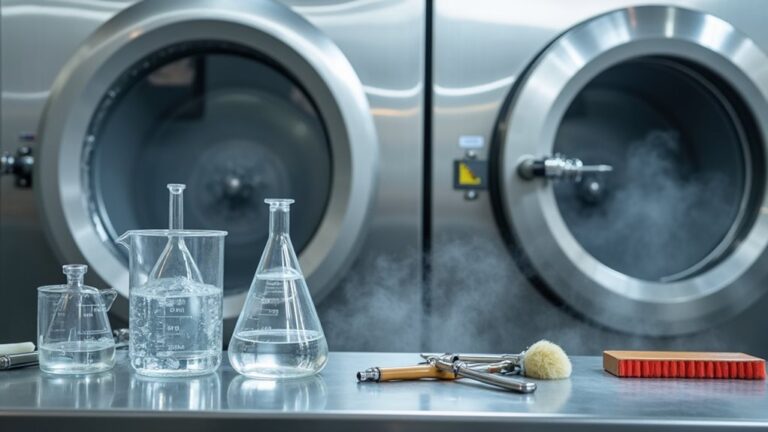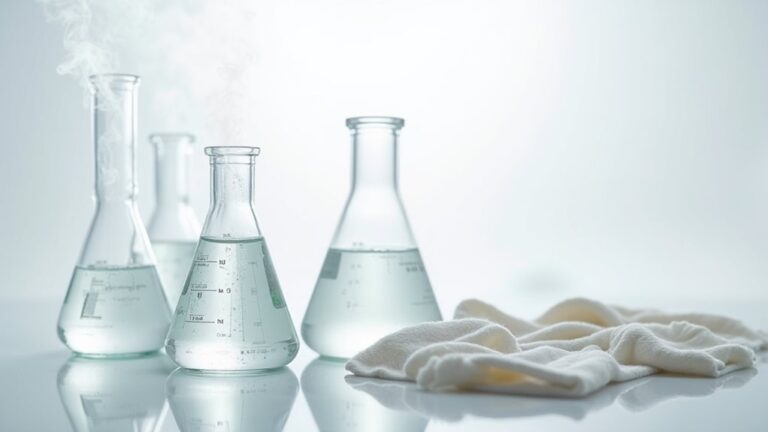Yes, dry cleaning chemicals are genuinely harmful to your health, and I learned this the hard way after years of headaches from freshly cleaned clothes. Traditional dry cleaners use perchloroethylene (PERC), which the EPA classifies as a cancer-causing chemical that clings to fabric fibers for weeks, affecting your indoor air quality and potentially causing dizziness, reproductive damage, and worse health issues over time. There are safer alternatives worth exploring.
What Chemicals Are Used in Traditional Dry Cleaning
The heart of traditional dry cleaning beats with a chemical called perchloroethylene, or PERC as it’s commonly known in the industry.
The chemical soul of dry cleaning pulses through perchloroethylene, PERC to those who know the trade’s dark secrets.
While this colorless liquid has been the go-to solvent for decades because of its incredible ability to dissolve oils and stains that water simply can’t touch, it carries a rather sobering classification from the U.S. National Toxicology Program as a human carcinogen.
When you drop off your favorite blazer, most dry cleaners use PERC because it’s remarkably effective, but these dry cleaning chemicals come with serious health risks that extend beyond the cleaning facility.
While alternatives to PERC exist, like n-propyl bromide, they’re not exactly winning any safety awards either, bringing their own toxic substances concerns and environmental impact that’ll make you think twice about that “dry clean only” label.
Exposure to these chemicals typically happens through residual chemical fumes on freshly cleaned garments, inhalation near dry cleaning facilities, and environmental contamination.
Health Risks Associated With PERChloroethylene (PERC) Exposure
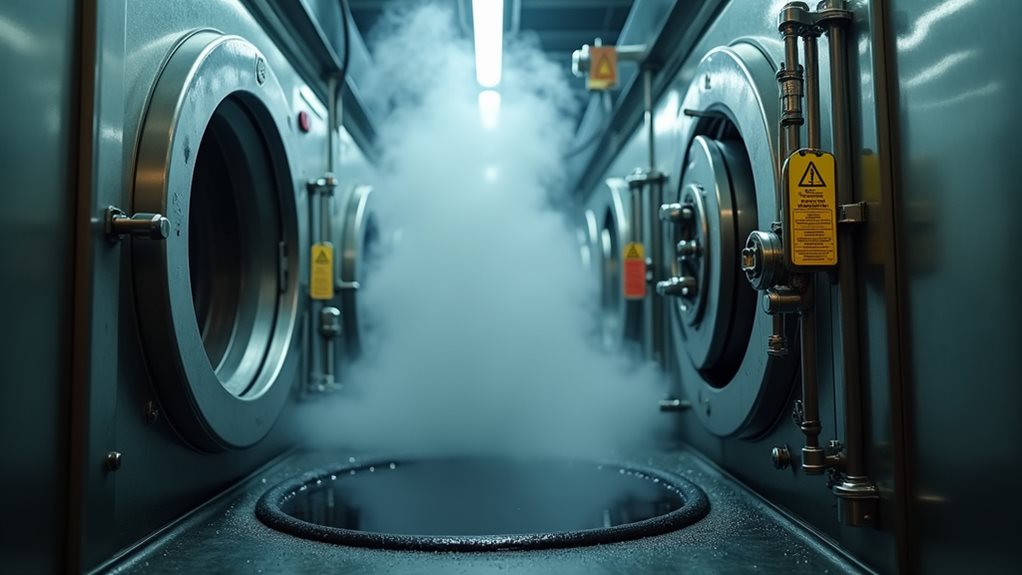
Understanding what chemicals lurk in your dry cleaning is just the beginning, because once you know that PERC is doing the heavy lifting on your garments, you’ll want to understand what this stuff actually does to your body when you’re exposed to it.
Here’s the sobering truth: perchloroethylene isn’t just tough on stains—it’s classified as one of those cancer-causing chemicals that makes the Environmental Protection Agency lose sleep at night.
Dry cleaning workers face the highest risks, dealing with headaches, dizziness, and potential reproductive system damage from daily exposure.
But here’s what’ll really get you—residual perc lingers on your clothes, vaporizing into your home’s air every time you wear that “clean” shirt, creating ongoing health effects none of us signed up for.
PERC exposure is particularly concerning for pregnant women, children, and those with existing health conditions who should avoid repeated or prolonged contact with this chemical solvent.
How Toxic Chemicals Remain on Your Clothing After Dry Cleaning

Most people assume their freshly dry-cleaned clothes are completely clean and safe to wear, but here’s the uncomfortable reality I discovered when I started digging into this topic—those garments are actually carrying invisible hitchhikers in the form of chemical residues that can stick around for days or even weeks.
When you bring home your dry-cleaned clothes, residual PERC clings to the fabric fibers, creating ongoing health risks every time you wear them. Georgetown University researchers found that wool, cotton, and polyester all retain notable levels of these toxic chemicals, and here’s the kicker—the contamination gets worse with repeated cleaning cycles.
These environmental pollutants don’t just disappear; they slowly release vapors into your home’s air, turning your closet into an unintentional exposure zone. The direct contact with your skin can lead to symptoms like dizziness and headaches, making proper ventilation of freshly cleaned garments essential before wearing them.
Environmental Impact of Dry Cleaning Solvents
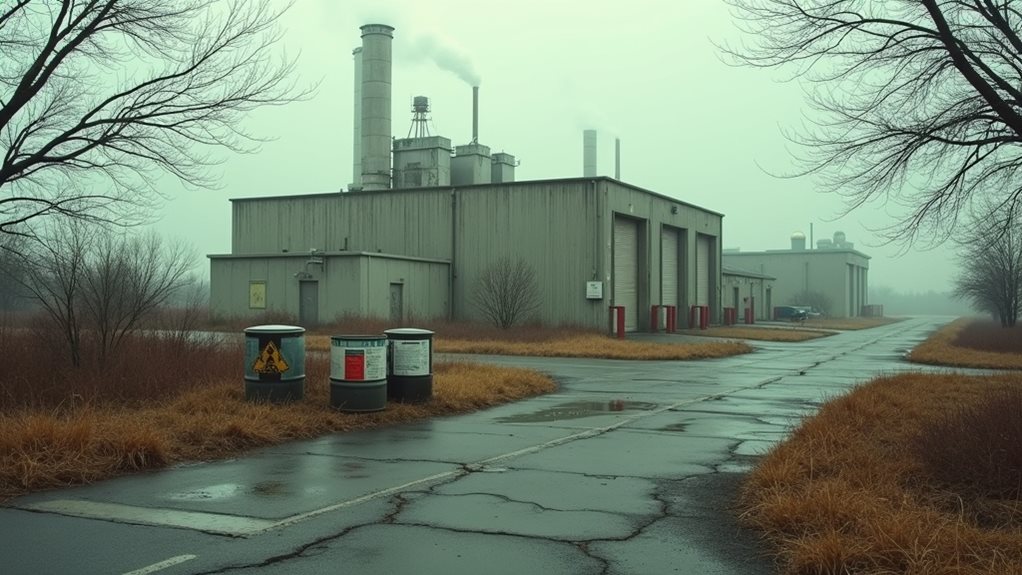
While you’re probably focused on how dry cleaning chemicals affect your personal health, I’ve learned that these same solvents are quietly wreaking havoc on our environment in ways that honestly shocked me when I first researched this topic.
The environmental impact of dry cleaning solvents includes:
- Air pollution persistence – Perchloroethylene escapes ventilation systems and lingers in outdoor air for weeks, creating long-term contamination.
- Ozone layer damage – Toxic byproducts from perc contribute to ozone depletion, amplifying environmental concerns.
- Ground contamination – Improper disposal and leaks harm local ecosystems and plant life through soil pollution.
- Water system threats – Contamination poses serious risks to marine life and drinking water safety.
Alternative solvents like n-propyl bromide aren’t much better, unfortunately affecting air, ground, and water quality with similar environmental persistence 😔
Fortunately, the dry cleaning industry has been transitioning to safer alternatives like hydrocarbon solvents and wet cleaning methods that significantly reduce environmental impact.
Alternative Chemicals and Their Safety Concerns
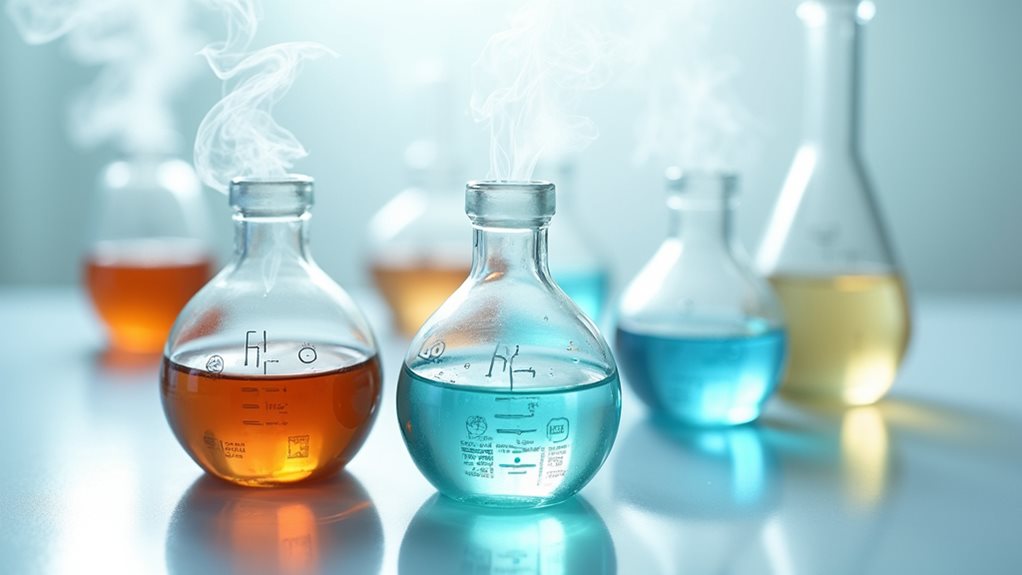
When I first discovered that the alternatives to traditional solvents weren’t necessarily safer, I felt like I’d been handed a menu where every option came with its own warning label.
N-propyl bromide might replace perc, but it brings dizziness, nausea, and potential reproductive damage to the table. Siloxane D5 sounds fancy and environmentally friendly, yet it carries cancer risks and environmental persistence that make you wonder if we’re just trading one problem for another.
Even hydrocarbon alternative solvents showed carcinogenic effects in animal studies, which honestly made my heart sink a little.
The bright spots? Liquid carbon dioxide and wet cleaning methods offer genuinely safer options without harmful residues, though many cleaners still resist these health risks-free alternatives due to effectiveness concerns.
Major health agencies like the EPA and International Agency for Research on Cancer have specifically classified traditional dry cleaning chemicals as probable human carcinogens, reinforcing concerns about safer alternatives.
Safer Eco-Friendly Dry Cleaning Methods Available Today

You’ve probably wondered if there’s a way to get your clothes professionally cleaned without worrying about those harsh chemicals we just discussed, and I’m excited to tell you that innovative methods like liquid carbon dioxide cleaning are revolutionizing the industry.
Professional wet cleaning has also emerged as a surprisingly effective alternative that uses nothing more than water and specialized detergents, proving that sometimes the simplest solutions are the most brilliant ones.
These eco-friendly approaches not just protect your health and the environment, but they’re also becoming more accessible in urban areas where forward-thinking cleaners are embracing these safer technologies.
Additionally, silicone-based solutions have joined the ranks of alternative solvents that maintain the same cleaning effectiveness for delicate fabrics while eliminating the health concerns associated with traditional perchloroethylene.
Liquid Carbon Dioxide Cleaning
Everyone deserves cleaner clothes without the worry of toxic chemicals seeping into their skin, and that’s exactly what liquid carbon dioxide cleaning delivers—a revolutionary dry cleaning method that transforms ordinary CO2 into a powerful, eco-friendly solvent.
Unlike traditional solvents that leave you wondering about lingering chemical residues, this non-toxic approach actually preserves your garments’ integrity while tackling stubborn stains effectively.
Here’s why this biodegradable method stands out:
- Operates at lower temperatures, protecting delicate fabrics and vibrant colors
- Leaves zero chemical residues on your clothes (finally, no weird smell!)
- Safe for sensitive skin and people with chemical sensitivities
- Reduces environmental impact without compromising cleaning power
Your health shouldn’t be compromised for clean clothes, and liquid carbon dioxide cleaning proves you don’t have to choose between effectiveness and safety.
Many certified green cleaners now offer CO2 cleaning alongside other alternative methods like wet cleaning and biodegradable solvents as safer options for health-conscious consumers.
Professional Wet Cleaning Methods
Professional wet cleaning takes the best parts of doing laundry at home—water and gentle detergents—and improves them with computer-controlled precision that would make your grandmother’s washing wisdom proud.
These professional wet cleaning methods use biodegradable detergents instead of harmful chemicals, creating a safer alternative to traditional dry cleaning solvents like perc that can literally take your breath away (and not in a good way 😅).
You’ll love knowing that eco-friendly dry cleaners using these techniques dramatically reduce environmental impact while eliminating carcinogenic risks from your wardrobe routine.
The specialized equipment handles even “dry clean only” garments with surprising gentleness, proving that sometimes the old-fashioned approach of water and soap, when paired with modern technology, beats harsh chemicals every single time.
For delicate fabrics that need extra care, gentle hand-washing with mild detergents provides another chemical-free option that maintains garment integrity while keeping you safe from toxic fumes.
How to Protect Yourself From Harmful Dry Cleaning Chemical Exposure
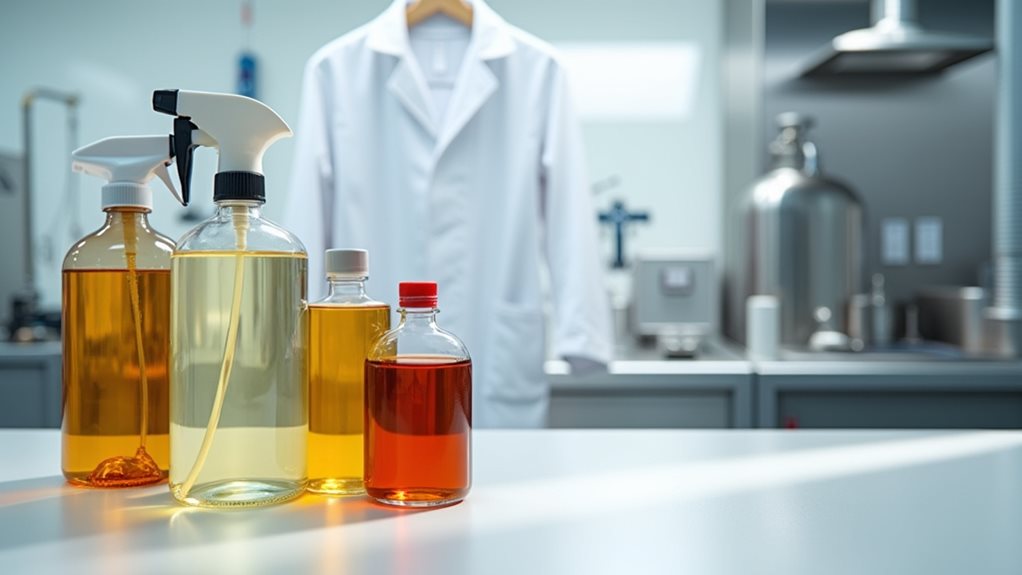
You don’t have to accept toxic chemical exposure as the price of clean clothes, and honestly, I used to think I was stuck with whatever my neighborhood dry cleaner offered until I learned there are actually simple ways to protect yourself.
The key lies in choosing safer alternatives when possible and reducing your overall chemical exposure through smart habits that’ll keep you and your family healthier.
I’ve discovered that being proactive about this stuff isn’t paranoid—it’s just common sense, especially when small changes can make such a big difference in the air quality of your home. 🏠
Many modern dry cleaners now offer eco-friendly options like wet cleaning and liquid CO2 cleaning that eliminate the need for harsh chemical solvents altogether.
Choose Safer Alternatives
While most of us don’t think twice about dropping off our favorite blazer at the nearest dry cleaner, taking a more intentional approach to choosing where and how you clean your garments can dramatically reduce your exposure to harmful chemicals.
I’ll admit, I used to choose my local dry cleaners based purely on convenience and price—until I learned about the health risks lurking in those freshly pressed shirts.
Now I’m that person who actually asks about the chemicals used, and honestly, it’s been eye-opening how willing most green dry cleaning businesses are to discuss their eco-friendly methods.
Here’s your game plan for safer cleaning:
- Ask potential dry cleaning services about their solvents—avoid PERC and n-propyl bromide
- Seek out shops using liquid carbon dioxide or wet cleaning techniques
- Try gentle hand washing for delicate items at home
- Research each safe alternative in your area before committing
Pregnant women and those with chemical sensitivities should be especially cautious with PERC exposure, as this probable carcinogen poses heightened risks to vulnerable populations.
Reduce Chemical Exposure
Even after you’ve found that perfect green dry cleaner, there’s still more you can do to shield yourself and your family from lingering chemical exposure that might be hiding in your freshly cleaned clothes.
First, always ask about the solvents your cleaner uses – avoiding PERC and n-propyl bromide isn’t just smart, it’s crucial for your health.
When you bring those garments home, resist the urge to hang them directly in your bedroom closet. Instead, store them in well-ventilated areas where any residual chemicals can dissipate safely.
I’ve learned that airing clothes outdoors works wonders for eliminating stubborn chemical odors.
Finally, reduce your overall exposure by limiting dry cleaning frequency – spot cleaning and wearing items multiple times helps minimize those eco-friendly trips.

